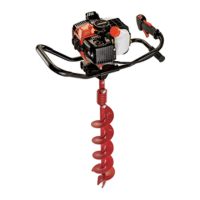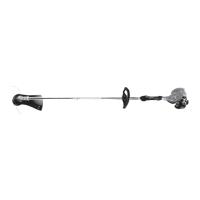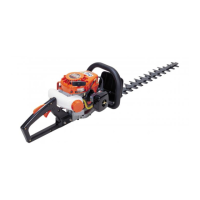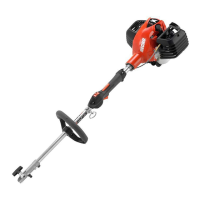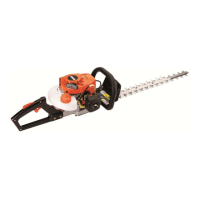- 8 -
©2023 ECHO Incorporated. All Rights Reserved
X7672230407
Push and Pull Forces
Push and pull forces are reactive forces that push
the equipment directly toward the operator, or that
pull the equipment directly away from the operator.
These forces are the result of cutting on the sides
of the blade. The direction of the force depends on
the side of the blade being used, and the direction
of blade rotation at the point of contact. The reactive
force is in the opposite direction of blade rotation at
the contact point, regardless of where the contact is
being made. These types of reactive forces are also
called “Blade Thrust.”
As shown in the illustration, a blade turning coun-
terclockwise will cause the equipment to pull away
from the operator if the point of cutting resistance
is on the left side of the blade. If the point of cut-
ting resistance is on the right side of the blade, the
equipment will push back toward the operator. In
both examples, the reactive force is in the opposite
direction of blade rotation at the contact point where
resistance occurs.
Kickout
Kickout is also a reactive force caused by resistance
to cutting, but the direction of blade thrust is lateral
(to the left or right of the blade), instead of forward
or back toward the operator.
In most cases, Push, Pull, and Kickout can be re-
duced or eliminated by:
• Using the correct blade for the cutting job.
• Using properly sharpened blades.
• Applying consistent, even force to the blade
during the cut.
• Avoiding obstacles and ground hazards.
• Using extra care when cutting harder materials
such as extremely dry brush, saplings, and small
trees.
• Cutting from a stable, secure position.
Blade Cutting Problems
Binding - Blades may bind in the cut if dull or forced.
Binding can damage blade, and result in blade
breakage or injury from fragments and ying debris.
If a blade binds in a cut, don’t try to get it out by
applying “up and down” force to pry the cut open.
Applying prying force to the blade can bend the
blade, and result in blade failure and injury.
To free a blade that is bound in the cut, stop the
unit, and support the trimmer or brushcutter to keep
stress off the blade. Push the tree away from the en-
try point of the cut to open the cut, and pull the blade
directly away from the cut in a straight-line motion.
Use caution when releasing the tree to avoid being
struck by spring-back or falling.
Inspect the blade for damage before proceeding.
Sharpen teeth if dull, or replace blade if cracked,
bent, missing teeth, or otherwise damaged.
To prevent binding:
• Keep blades sharp
• Avoid excessive pressure during cuts
• Don’t exceed cutting capacity of blade
• Don’t use blades with damaged or missing cut-
ting teeth
• Don’t rock blades in cut

